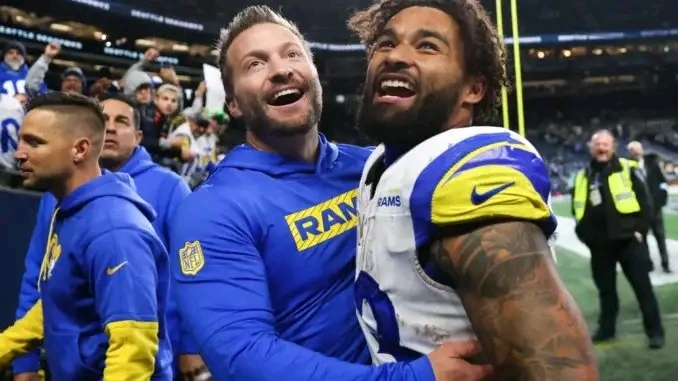The Los Angeles Rams have plenty of motivation to offer an extension to standout running back Kyren Williams. Over the past two seasons, he’s been a steady and impactful part of their offense. His strong performances have been key in helping the Rams rebound from slow starts to thrilling finishes in both the 2023 and 2024 seasons.
Williams, along with wide receiver Puka Nacua, has helped maintain the Rams’ reputation for having a potent offense. So, it’s easy to see why fans are so eager to see the team lock him up long-term. With 2025 marking the final year of his rookie deal, the Rams face a decision: either let him hit free agency or work out an extension to keep him in Los Angeles.
Right now, Williams seems optimistic about getting a new deal done
But before getting too excited, it’s worth recalling some recent history.
After their Super Bowl LIII appearance, the Rams handed out several major contracts—only to later regret some of them. Todd Gurley, Brandin Cooks, and Jared Goff were all released or traded after failing to meet the high expectations of those deals. In hindsight, those costly contracts didn’t always deliver the expected return.
So what about Williams? He doesn’t carry the same injury concerns that Gurley did, and his play has been impressive. Still, it’s important not to overlook the limitations in both the Rams’ offensive approach and in Williams’ own game. There are valid reasons to approach an extension with caution.
This isn’t to say Williams doesn’t deserve a new contract. But in any negotiation, the best deals are those that anticipate various outcomes and include clear solutions that both sides accept. The Rams’ previous high-profile contracts failed to plan for the challenges that eventually arose, forcing them to make tough decisions.
To avoid repeating past mistakes, both the team and Williams should work to ensure any new deal is thorough and balanced—accounting for potential risks while rewarding strong performance.
The devil is in the details
When it comes to NFL contracts, player priorities are pretty straightforward—it’s all about guaranteed money. Regardless of how healthy they are, how many snaps they play, or how many carries a running back gets, players want the assurance of a paycheck. And that’s entirely reasonable. After all, imagine working for a company that stops paying you the moment you get injured on the job.
Football, especially the NFL, comes with a high risk of injury—both in frequency and severity.
From a team’s perspective, however, things look quite different. If a player gets hurt, the team still has to fill that role—often by paying another player—while also continuing to pay the injured one. That means doubling up on costs for a single position.
Naturally, teams want to get the most value from their contracts. Most deals aren’t heavily tied to a player’s role or performance metrics like total yards or yards per carry. Once a player makes the roster, playing time is largely up to the coaching staff.
This brings us to the Rams and their challenge in managing the running back position effectively.
Kyren Williams was leaned on heavily in 2024. As his workload increased, his explosiveness waned, ball security became an issue, and injury risks rose. His overall efficiency declined as evidenced by a noticeable drop in yards per carry.
Here’s how the Rams divided up their 2024 carries, according to Lineups.com:
-
Kyren Williams: 888 snaps | 316 carries | 1,299 yards | 14 TDs
-
Blake Corum: 119 snaps | 58 carries | 207 yards | 0 TDs
-
Ronnie Rivers: 81 snaps | 22 carries | 99 yards | 0 TDs
-
Cody Schrader: 2 snaps | 1 carry | 3 yards | 0 TDs
Williams was on the field for nearly 82% of the offensive snaps, an overwhelming share. If the Rams want to lighten his load in 2025, any contract extension should take that shift into account. The coaching staff must also improve how they distribute offensive opportunities.
Compare that to teams like the Lions and Buccaneers, who thrived offensively in 2024 by effectively using a running back committee. The Rams, on the other hand, failed to get meaningful production from Corum and the rest of the backfield.
Now, with Jarquez Hunter and Jordan Waters added to an already crowded room, the question becomes: how much is too much? If you look at the numbers from last season, it could be argued that the roster reached its saturation point the moment Ronnie Rivers was re-signed.
Resources are limited, and the Rams are currently allocating almost 2.5 times more of their cap space to offense than defense, per OverTheCap.com. Should they keep spending so heavily on offense while neglecting defensive needs?
The Rams need to pause and reassess. With Corum, Rivers, Schrader, Hunter, and Waters already in the mix, it’s time to figure out which backs can provide real value—and which investments may not be worth the cost.


